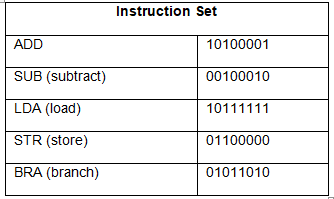Year 11 Exam > Year 11 Notes > Computer for GCSE/IGCSE > Instruction Sets
Instruction Sets | Computer for GCSE/IGCSE - Year 11 PDF Download
Instruction Sets
- An instruction set comprises a comprehensive list of commands executable by a CPU.
- Each command is associated with a distinct binary code.
- The provided table illustrates a sample instruction set, where each instruction is identified by a mnemonic describing its function, accompanied by its respective binary code.

- Following the decoding of an instruction into an opcode and an operand, the CPU references the processor's instruction set to identify the opcode, thereby determining the operation to execute when processing the instruction.
Machine-Specific Instruction Lists
- Instruction lists are specific to each machine, indicating that a program designed using one computer's instruction set may not function on a device with a processor from a different manufacturer.
- For instance, a program crafted using Intel's instruction set would be incompatible with a device housing an ARM processor.
Question for Instruction SetsTry yourself: What is an instruction set?View Solution
The document Instruction Sets | Computer for GCSE/IGCSE - Year 11 is a part of the Year 11 Course Computer for GCSE/IGCSE.
All you need of Year 11 at this link: Year 11
|
92 docs|30 tests
|
FAQs on Instruction Sets - Computer for GCSE/IGCSE - Year 11
| 1. What are Instruction Sets in computer science? |  |
Ans. Instruction Sets are a set of commands that a computer's CPU can execute. These commands are used to perform specific functions and operations on data within the computer.
| 2. Why are Instruction Sets important in programming? |  |
Ans. Instruction Sets are important in programming as they determine the operations that a computer can perform. By using different instructions, programmers can control how data is processed and manipulated by the CPU.
| 3. How are Instruction Sets classified? |  |
Ans. Instruction Sets are classified based on the type of operations they perform, such as arithmetic, logic, and data transfer operations. They can also be classified based on the number of operands they use, such as single operand or double operand instructions.
| 4. Can Instruction Sets vary between different computer architectures? |  |
Ans. Yes, Instruction Sets can vary between different computer architectures. Each architecture may have its own set of instructions and formats for specifying operations to be performed by the CPU.
| 5. How do compilers and assemblers interact with Instruction Sets? |  |
Ans. Compilers and assemblers translate high-level programming languages into machine code that is compatible with a specific Instruction Set. They ensure that the instructions generated are appropriate for the target platform's architecture.

|
Explore Courses for Year 11 exam
|

|
Signup for Free!
Signup to see your scores go up within 7 days! Learn & Practice with 1000+ FREE Notes, Videos & Tests.
Related Searches

















